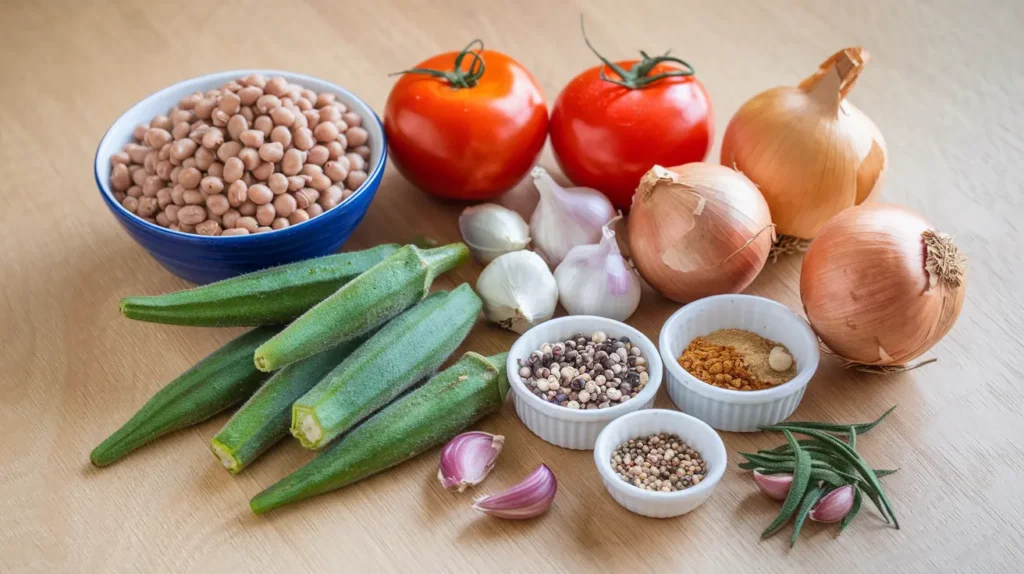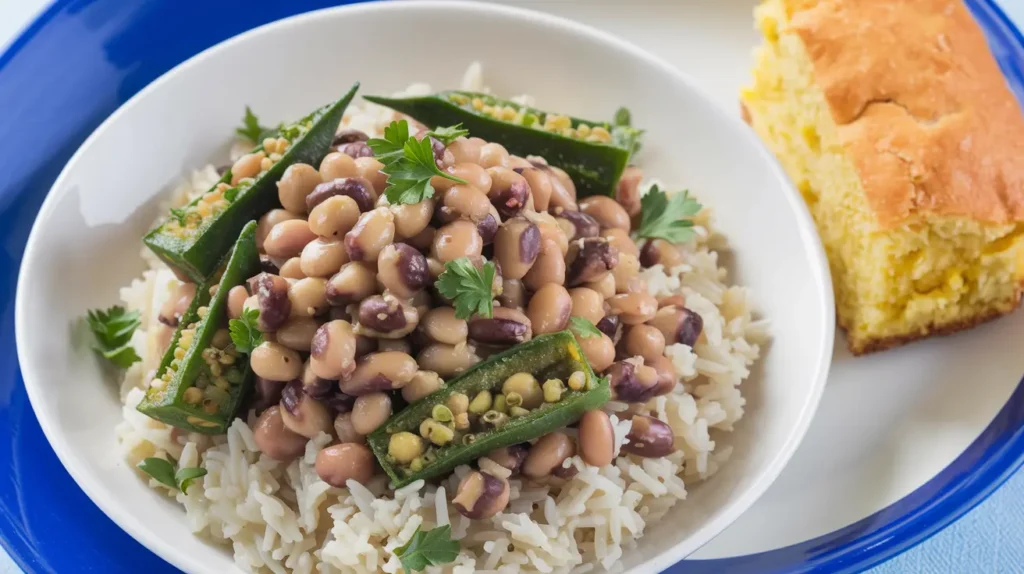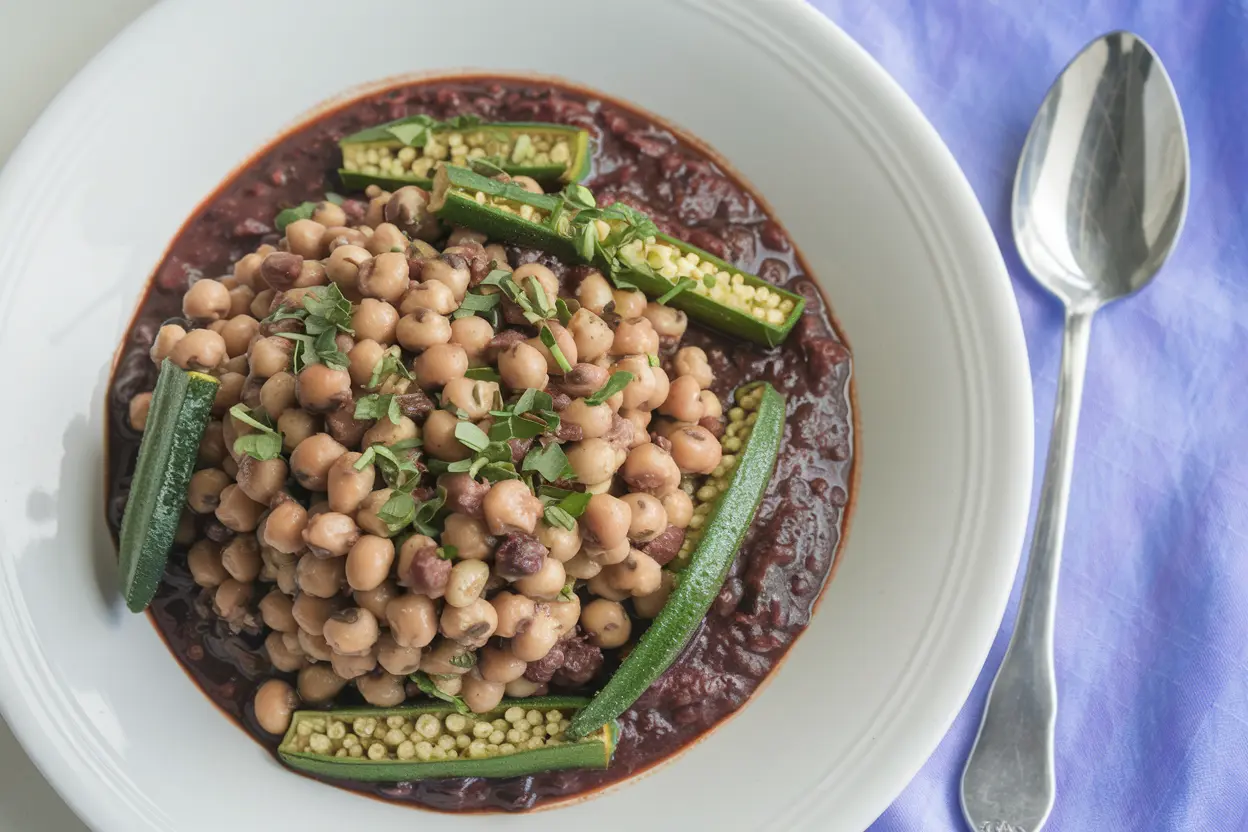Black eyed peas with okra is a timeless recipe celebrated for its hearty flavors, nutritional benefits, and comforting qualities. This classic dish, rooted in Southern cuisine, combines tender black eyed peas and fresh okra into a flavorful masterpiece. Whether you’re looking for a side dish, a main course, or a vegetarian option, black eyed peas with okra offers endless versatility and delicious possibilities.
In this guide, we’ll walk you through everything you need to know to prepare the perfect black eyed peas with okra, from selecting the best ingredients to mastering the cooking techniques that ensure rich flavor and satisfying texture. Let’s dive in!
Table of Contents
Ingredients Overview for Black Eyed Peas with Okra

To make the best black eyed peas with okra, start with the freshest and most flavorful ingredients. Understanding these components will elevate your dish to perfection.
Key Ingredients and Variations
- Black Eyed Peas: Opt for dried, frozen, or canned. Dried peas offer maximum flavor, while canned peas are convenient.
- Fresh Okra: Look for firm and bright green pods for the best results. Frozen okra can be used if fresh is unavailable.
- Broth: Chicken or vegetable broth adds depth to the dish.
- Onions and Garlic: Essential aromatics that form the flavor base.
- Tomatoes: Use fresh or canned diced tomatoes for a tangy touch.
- Seasonings: Incorporate smoked paprika, thyme, cayenne, and salt to enhance the dish.
- Optional Additions: Add smoked meat (like ham hock or bacon) or keep it vegan with additional vegetables like bell peppers.
Health Benefits of Black Eyed Peas and Okra
- Rich in Nutrients: Black eyed peas are high in protein, fiber, and iron, while okra provides vitamins C and K.
- Gut Health: Both ingredients are excellent sources of dietary fiber.
- Heart-Friendly: Low in fat and cholesterol, this dish supports cardiovascular health.
Preparing the Ingredients
Proper preparation ensures your black eyed peas with okra dish turns out flavorful and well-cooked. Follow these steps to get everything ready.
How to Clean and Chop Okra
- Rinse Thoroughly: Wash the okra under cold running water to remove any dirt or debris.
- Trim the Ends: Use a sharp knife to cut off both ends of the okra pods.
- Slice or Leave Whole: Depending on your preference, slice the okra into small rounds or leave them whole for a chunkier texture.
Pro Tip: To minimize the “slimy” texture, avoid cutting okra until you’re ready to cook it and consider briefly blanching it in hot water.
Prepping Black Eyed Peas (Dry and Canned)
- Dry Black Eyed Peas:
- Rinse thoroughly under cold water to remove dirt or debris.
- Soak in water for 6–8 hours or overnight. This reduces cooking time and improves texture.
- Drain and set aside.
- Canned Black Eyed Peas:
- Drain and rinse under cold water to remove excess sodium and preserve natural flavors.
Pro Tip: If you’re in a hurry, you can skip soaking dry peas by using the quick-soak method. Boil them for 2 minutes, cover, and let sit for 1 hour before cooking.
Cooking Techniques
Mastering the right cooking techniques is crucial for achieving the perfect texture and flavor in your black eyed peas with okra dish.
Sautéing vs. Boiling: Best Methods
- Sautéing:
Sautéing the okra and aromatics before combining them with the black eyed peas enhances the flavor. Use a heavy-bottomed skillet with a splash of oil to achieve slight caramelization. - Boiling:
This method is best for softening the black eyed peas. Simmer them in broth to infuse them with flavor while keeping them tender.
Pro Tip: Combine both methods by sautéing the vegetables first, then simmering everything together for a richly flavored dish.
Adding Flavor with Spices and Herbs
- Essential Spices: Smoked paprika, cayenne, black pepper, and thyme create a robust flavor profile.
- Aromatics: Sauté onions, garlic, and celery for a deep, savory base.
- Fresh Herbs: Add parsley or cilantro at the end for a burst of freshness.
Pro Tip: For an authentic Southern touch, include a smoked meat element like a ham hock or smoked turkey leg.
Step-by-Step Recipe for Black Eyed Peas with Okra
This detailed recipe will guide you through cooking black eyed peas with okra to perfection, combining traditional techniques with practical tips.
Cooking Black Eyed Peas with Okra: Detailed Steps
- Prepare the Ingredients:
- Soak and rinse the black eyed peas if using dried ones.
- Clean and slice the okra.
- Chop onions, garlic, and any additional vegetables (like tomatoes or bell peppers).
- Sauté Aromatics:
- Heat 2 tablespoons of oil in a large pot or skillet over medium heat.
- Add chopped onions, garlic, and celery. Sauté until softened and aromatic.
- Cook the Black Eyed Peas:
- If using dried peas, add them to the pot with enough broth to cover.
- Bring to a boil, then reduce to a simmer. Cover and cook for 30–40 minutes or until tender.
- For canned peas, add them after sautéing the aromatics and simmer for 10 minutes.
- Add Okra and Spices:
- Stir in the sliced okra, tomatoes, and spices (smoked paprika, cayenne, thyme, salt, and pepper).
- Simmer for an additional 15–20 minutes, stirring occasionally, until the okra is tender and the flavors meld.
- Check and Adjust:
- Taste the dish and adjust seasonings as needed.
- Add a splash of vinegar or a pinch of sugar to balance the flavors, if desired.
Common Mistakes to Avoid
- Overcooking Okra: This can make the dish overly slimy. Add okra toward the end of cooking.
- Skipping the Aromatics: Onions and garlic are essential for a flavorful base.
- Undercooking Dried Black Eyed Peas: Ensure they are fully cooked before adding other ingredients.
Serving Suggestions

Black eyed peas with okra is a versatile dish that can shine as a comforting main course or a hearty side. Enhancing your presentation and pairing it with complementary dishes can take your meal to the next level.
Pairing with Rice or Cornbread (Expanded)
- Rice Options:
- Steamed white rice is the traditional choice, creating a satisfying base that absorbs the dish’s flavorful broth.
- Brown rice adds a nutty flavor and pairs well with the hearty peas and okra.
- For a unique twist, consider serving the dish over wild rice or a rice pilaf infused with herbs and spices.
- Cornbread Options:
- Traditional Southern cornbread with a crispy crust and moist interior perfectly complements the dish.
- Experiment with variations like jalapeño cheddar cornbread for a spicy, cheesy kick or honey cornbread for a touch of sweetness.
- Mini cornbread muffins or skillet cornbread wedges make individual servings easy and appealing.
Garnishing Ideas
- Fresh Herbs:
- Fresh parsley adds a burst of greenery and a mild, peppery flavor.
- Chopped cilantro pairs beautifully for those who enjoy its distinctive citrusy notes.
- Thinly sliced green onions provide a mild oniony bite and a pop of color.
- Hot Sauce and Spice Boosters:
- Serve with a variety of hot sauces, from mild to fiery, allowing diners to customize the heat.
- A drizzle of chili oil or a sprinkle of red pepper flakes can add an extra layer of spice.
- Crunchy Toppings:
- Crumbled bacon adds a smoky, salty crunch.
- Fried onions or garlic chips offer a crispy texture and deep umami flavor.
- Toasted breadcrumbs seasoned with paprika or garlic powder can also be a delightful topping.
Beverage Pairings
- Iced Tea: A classic pairing for Southern dishes, unsweetened or sweetened iced tea balances the dish’s savory flavors.
- Wine: Pair with a light white wine like Sauvignon Blanc or a medium-bodied red like Pinot Noir to complement the earthy and spicy notes.
- Beer: A crisp lager or a rich amber ale works well to balance the dish’s hearty flavors.
Additional Serving Options
- As a Side Dish:
- Serve alongside fried chicken, baked fish, or a grilled steak for a complete Southern-style meal.
- Pair with roasted vegetables or sautéed greens like collards or kale for a vegetarian-friendly spread.
- Family-Style Presentation:
- Present the dish in a large, colorful serving bowl and place it in the center of the table for sharing.
- Provide small bowls of garnishes like chopped herbs, crumbled bacon, and hot sauce, allowing everyone to customize their serving.
Creative Serving Ideas
- Stuffed Peppers: Use the black eyed peas and okra as a filling for roasted bell peppers for a unique presentation.
- Baked Casserole: Combine the prepared dish with cooked pasta or rice, sprinkle with cheese, and bake until bubbly for a comforting casserole.
- Savory Pastries: Use the dish as a filling for hand pies or turnovers for a portable, savory snack.
Expanded Presentation Tips
- Rustic Elegance: Use earthenware bowls or wooden serving trays for a farmhouse-inspired presentation.
- Bright Accents: Add a few lemon or lime wedges on the side of each plate for a fresh citrus kick that enhances the flavors.
- Individual Portions: Serve in small bowls or ramekins for an elegant dinner party setup.
For a delicious pairing, try serving black eyed peas with okra alongside a comforting dish like One-Pan Cheesy Chicken Pasta: Restaurant-Style Secret. The creamy, cheesy pasta balances the hearty and earthy flavors of the peas and okra beautifully.
Tips for Variations
Black eyed peas with okra is an adaptable dish, making it easy to customize to suit dietary preferences, flavor profiles, and available ingredients. Here are detailed tips for creating variations of this classic recipe.
Vegan and Vegetarian Modifications
- Plant-Based Broth: Use vegetable broth instead of chicken broth for a fully vegan base that retains depth of flavor.
- Add Extra Vegetables: Enhance the dish’s nutritional profile with ingredients like:
- Bell Peppers: Diced red or green bell peppers add sweetness and color.
- Carrots: Thinly sliced or diced carrots contribute a subtle sweetness and vibrant hue.
- Zucchini: Diced zucchini blends well with okra for a heartier texture.
- Boost Flavor with Umami:
- Add a splash of soy sauce or tamari for a savory kick.
- Sprinkle nutritional yeast for a cheesy, umami-rich flavor.
Adding Meat or Seafood
- Smoked Meats: Incorporate traditional proteins like:
- Ham Hocks: Simmer with the black eyed peas for a smoky depth.
- Smoked Sausage: Slice and brown before adding for added flavor.
- Bacon: Fry until crispy, then crumble over the finished dish or stir in during cooking.
- Seafood Options:
- Shrimp: Sauté shrimp with garlic and spices, then add toward the end of cooking.
- Crab Meat: Stir in lump crab meat for a luxurious twist.
- Catfish or Cod: Serve the dish alongside a fillet of pan-fried fish for a Southern-style seafood pairing.
Regional Flavor Twists
- Creole Style:
- Add a roux (equal parts flour and fat cooked together) to thicken the dish.
- Include Creole spices like oregano, cayenne, and celery seed.
- Serve with rice and top with chopped green onions for a true Louisiana vibe.
- African-Inspired:
- Use palm oil for cooking to achieve a rich, authentic taste.
- Incorporate ground peanuts or peanut butter for a nutty flavor.
- Add a touch of ginger and scotch bonnet pepper for heat and depth.
- Indian Influence:
- Add curry powder or garam masala for a warming spice profile.
- Stir in coconut milk for a creamy, aromatic base.
- Serve with naan or basmati rice.
Texture and Flavor Enhancements
- Thicker Stew:
- Mash a small portion of the black eyed peas after cooking to create a thicker, heartier texture.
- Stir in a tablespoon of tomato paste for a richer base.
- Crunchy Toppings:
- Toasted breadcrumbs mixed with parmesan cheese can add a satisfying crunch.
- Spiced nuts or seeds (like smoked almonds or pumpkin seeds) offer texture and a unique flavor.
- Smoky and Spicy Additions:
- Smoked paprika or chipotle powder can enhance the smoky notes without meat.
- For heat lovers, consider adding diced jalapeños, habaneros, or a drizzle of spicy chili oil.
Creative Ingredient Swaps
- Legume Substitutes: If black eyed peas aren’t available, you can use:
- Cannellini beans for a creamier texture.
- Lentils for a quicker-cooking alternative.
- Chickpeas for a firmer, nuttier option.
- Okra Alternatives: If okra is unavailable, consider:
- Green beans for a milder flavor.
- Zucchini or eggplant for a similar texture.
- Frozen peas or edamame for a bright and fresh substitute.
Seasonal Variations
- Winter Version:
- Add hearty root vegetables like sweet potatoes or turnips for a warming, seasonal touch.
- Include a dash of cinnamon or nutmeg to complement the winter vibe.
- Summer Version:
- Incorporate fresh, juicy tomatoes and sweet corn for a light, sunny flavor.
- Serve chilled as a salad-style dish for a refreshing twist.
Dietary Considerations
- Low-Sodium Option:
- Use low-sodium broth and rinse canned beans to reduce salt.
- Season with fresh herbs and citrus zest to enhance flavor naturally.
- Low-Carb Option:
- Skip the rice and serve over cauliflower rice or zucchini noodles.
- Add extra greens like kale or spinach for bulk without carbs.
- High-Protein Boost:
- Add cooked quinoa or farro to the dish.
- Stir in grilled chicken or tofu for extra protein.
Storage and Leftovers
Black eyed peas with okra is a dish that stores well and often tastes even better the next day as the flavors meld. Here are the best practices for storage and creative ways to enjoy leftovers.
Best Ways to Store Cooked Black Eyed Peas with Okra
- Refrigeration:
- Allow the dish to cool to room temperature before storing.
- Transfer to an airtight container and refrigerate for up to 4–5 days.
- Reheat in a saucepan over medium heat, adding a splash of water or broth to prevent sticking.
- Freezing:
- Portion the dish into freezer-safe containers or resealable bags for easy thawing.
- Freeze for up to 3 months. Label with the date to keep track.
- Thaw overnight in the refrigerator or reheat directly on the stove from frozen, stirring occasionally.
Pro Tip: If freezing, avoid adding garnishes like fresh herbs or crispy toppings until after reheating for the best texture.
Creative Ways to Reuse Leftovers
- Stuffed Bell Peppers:
- Hollow out bell peppers, stuff them with the leftover black eyed peas and okra, and bake at 375°F (190°C) for 20–25 minutes.
- Hearty Soup:
- Add leftover black eyed peas with okra to a pot with extra broth, diced vegetables, and cooked pasta or rice to create a flavorful soup.
- Tacos or Wraps:
- Use the leftovers as a filling for tortillas or wraps. Top with shredded lettuce, diced tomatoes, and a dollop of sour cream or guacamole.
- Savory Breakfast:
- Serve warmed leftovers alongside scrambled eggs and toast for a protein-packed breakfast.
- Create a breakfast hash by mixing the dish with diced potatoes and frying it in a skillet.
- Casserole Base:
- Layer leftovers with cooked pasta or mashed potatoes in a baking dish. Top with cheese and bake until golden and bubbly.
Tips for Reheating Without Losing Flavor
- Stovetop: Reheat slowly over medium heat, stirring often, and add a splash of broth or water to maintain the dish’s consistency.
- Microwave: Cover the dish with a microwave-safe lid or damp paper towel to retain moisture. Heat in 1-minute intervals, stirring in between.
- Oven: For large portions, reheat in a covered baking dish at 350°F (175°C) for about 20 minutes, stirring halfway through.
Nutritional Information
Black eyed peas with okra is a nutrient-dense dish that combines plant-based protein, fiber, and vitamins. Below is a breakdown of the approximate nutritional values for one serving (1 cup), depending on ingredients used.
| Nutrient | Amount per Serving | Health Benefits |
|---|---|---|
| Calories | ~180–220 kcal | Provides energy while remaining low-calorie and satisfying. |
| Protein | 8–10 g | Supports muscle repair and overall health. |
| Fat | 5–7 g | Mostly healthy fats from olive oil or optional meat. |
| Carbohydrates | 25–30 g | Offers sustained energy with fiber-rich carbs. |
| Fiber | 8–10 g | Promotes digestion and gut health. |
| Vitamin C | ~20% of DV | Boosts immunity and skin health from okra and tomatoes. |
| Vitamin A | ~10% of DV | Supports vision and immune function. |
| Calcium | ~5% of DV | Contributes to bone health. |
| Iron | ~10% of DV | Helps prevent anemia and supports oxygen transport. |
| Sodium | 400–600 mg | Controlled by using low-sodium broth or rinsing canned peas. |
DV: Daily Value
Custom Adjustments for Dietary Needs
| Modification | Effect on Nutrition |
|---|---|
| Use plant-based broth | Reduces fat and cholesterol for a vegan version. |
| Add smoked meat | Increases protein and adds rich, smoky flavor. |
| Skip rice or cornbread | Lowers carbohydrates for a low-carb meal. |
| Add extra vegetables | Boosts vitamins and minerals, enhancing nutrition. |
Final Thoughts
Summary of Key Points:
- Black eyed peas with okra is a versatile, hearty, and nutritious dish rooted in Southern culinary traditions.
- The dish combines the protein and fiber of black eyed peas with the vitamins and minerals of fresh okra.
- By using the right techniques, such as sautéing aromatics and simmering in flavorful broth, you can create a richly textured and flavorful meal.
- Variations like vegan adaptations, adding smoked meat or seafood, and regional twists make this recipe adaptable to any palate.
- Proper storage ensures leftovers remain tasty and provide opportunities for creative reuse in dishes like casseroles, soups, or breakfast hashes.
Enjoy making this dish your own by experimenting with ingredients and garnishes to suit your taste.
FAQ
1. What are the main benefits of eating black eyed peas with okra?
Black eyed peas with okra is rich in fiber, protein, and essential vitamins, promoting digestion, heart health, and immunity.
2. Can I make black eyed peas with okra vegan?
Yes, substitute chicken broth with vegetable broth and skip meat to enjoy a vegan black eyed peas with okra recipe.
3. How do I prevent okra from becoming slimy in black eyed peas?
To reduce slime, keep okra whole or add it toward the end of cooking. Blanching before cooking also helps.
4. What meat pairs well with black eyed peas with okra?
Smoked meats like ham hocks, bacon, or sausage pair wonderfully, adding depth and a smoky flavor to the dish.
5. How long can I store black eyed peas with okra in the fridge?
Stored in an airtight container, black eyed peas with okra lasts 4–5 days in the refrigerator.
6. Can I use canned black eyed peas for this recipe?
Yes, canned black eyed peas are convenient and reduce cooking time. Rinse before using to remove excess salt.

